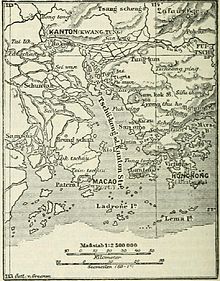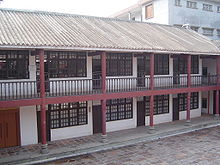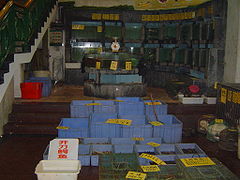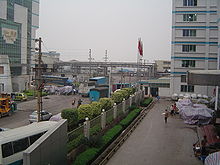Guangzhou
| Guǎngzhōu Shì 广州 市 Guangzhou (Canton) |
||
|---|---|---|
 Above: View over Tianhe from Baiyun Shan; Middle, from left: Canton Tower , Bridge over the Pearl River , Sun Yat-sen Memorial Hall, statue of the Five Goats; Below: Zhenhai Tower, Sacred Heart Cathedral |
||
|
|
||
| Coordinates | 23 ° 8 ' N , 113 ° 16' E | |
 Guangzhou's location in Guangdong |
||
| Basic data | ||
| Country | People's Republic of China | |
| region | South china | |
| province | Guangdong | |
| ISO 3166-2 | CN-GD | |
| status | Sub-provincial town | |
| structure | 10 city districts, 2 independent cities | |
| height | 21 m | |
| surface | 3843 km² | |
| Metropolitan area | 7434 km² | |
| Residents | 11,114,200 (2011) | |
| Metropolitan area | 14,043,500 (2016) | |
| density | 2,892.1 Ew. / km² | |
| Metropolitan area | 1,889.1 Ew. / km² | |
| Post Code | 510000 | |
| Telephone code | (+86) 20 | |
| Time zone | China Standard Time (CST) UTC +8 |
|
| License Plate | 粤 A | |
| Website | www.gz.gov.cn | |
| politics | ||
| mayor | Wen Guohui (温国辉) | |
| economy | ||
| GDP | 1,542,000 million ¥ 120,515 per capita (2013) |
|
Guangzhou , exonym : Canton ( Chinese 廣州 市 / 广州 市 , Pinyin Guǎngzhōu Shì , IPA ( standard Chinese) [ kwɑŋ21ʈʂɔw5 ], W.-G. Kuang³-chou¹ , Jyutping Gwong 2 zau 1 Si 5 , English Canton , outdated Post Kwong Chow , Abbrev .: 穗 , Suì , Jyutping Seoi 6 ), is a city in the south of the People's Republic of China with 11,114,200 inhabitants in the geographical urban area and 14,043,500 inhabitants in the administrative urban area (as of the end of 2011 and 2016). It is the capital of the province of Guangdong and an important industrial and commercial location. The region is also known as the “factory of the world”.
Guangzhou is the largest city in the Pearl River Delta , one of the largest contiguous urban landscapes (megalopoles) in the world. In addition to Guangzhou, the Pearl River Delta also includes the megacities of Hong Kong , Shenzhen , Dongguan , Foshan , Jiangmen , Huizhou , Zhongshan and Zhuhai with a combined population of more than 60 million.
The term canton used in German (and similarly in other western languages) goes back to the name of the province of Guangdong. In China, Guangzhou is also called 穗 城 , Suìchéng , Jyutping Seoi 6 sing 4 - "City of ears" or 羊城 , Yángchéng , Jyutping Joeng 4 sing 4 - "City of the goats". The symbol of the city is a statue with five goats. As in the entire Pearl River Delta , its proximity to Hong Kong has had a positive impact on economic development. The Canton Fair , China's largest import and export fair, takes place twice a year in Guangzhou - in spring and autumn . In October 2010 the highest television tower in the world ( Canton Tower , 600 m) was opened here, and in 2012 this record went to the Tokyo Skytree .
Geography and climate
Guangzhou is located on the Pearl River. The geographical location due prevails in Guangzhou a subtropical -feuchtes monsoon climate , with an annual average temperature of 22 ° C . Most of the precipitation (annual average: 1,982 mm) falls in the rainy season from April to August.
|
Average monthly temperatures and rainfall for Guangzhou
Source: wetterkontor.de
|
|||||||||||||||||||||||||||||||||||||||||||||||||||||||||||||||||||||||||||||||||||||||||||||||||||||||||||||||||||||||||||||||||||||||||||||||||||||||||||||||||||||
Administrative structure
At the county level, the sub-provincial city of Guangzhou is made up of eleven districts . The Guangzhou People's Government is located in the Yuexiu District . On April 28, 2005, the Dongshan and Fangcun Districts were dissolved and incorporated into Yuexiu and Liwan . In addition, the Nansha District was spun off from Panyu and the Luogang District was established from parts of Baiyun , Tianhe , Zengcheng, and part of Huangpu , which forms an exclave of the new city district. In February 2014, Luogang was dissolved again and its area integrated into the Huangpu district. At the same time, the two independent cities of Conghua and Zengcheng were converted into city districts.
| Administrative division of Guangzhou | |||||
|---|---|---|---|---|---|
| Borough | chinese name | Hanyu Pinyin | Population (2010 census) |
Area in km² |
Population density (inh / km²) |
| Baiyun | 白云 区 | Báiyún Qū | 2,222,658 | 795.79 | 2,793 |
| Conghua | 从 化 区 | Cónghuà Qū | 593,415 | 1,974.50 | 301 |
| Haizhu | 海珠区 | Hǎizhū Qū | 1,558,663 | 90.40 | 17,242 |
| Huadu | 花都 区 | Huādū Qū | 945.053 | 970.04 | 974 |
| Huangpu | 黄埔 区 | Huángpù Qū | 831,600 | 484.17 | 1,718 |
| Liwan | 荔湾 区 | Lìwān Qū | 898.204 | 59.10 | 15.198 |
| Nansha | 南沙 区 | Nánshā Qū | 259,899 | 527.65 | 493 |
| Panyu | 番禺 区 | Pānyú Qū | 1,764,869 | 786.15 | 2,245 |
| Tianhe | 天河 区 | Tiānhé Qū | 1,432,431 | 96.33 | 14,870 |
| Yuexiu | 越秀 区 | Yuèxiù Qū | 1,157,277 | 33.80 | 34,239 |
| Zengcheng | 增 城区 | Zēngchéng Qū | 1,036,731 | 1,616.47 | 641 |
| Total | 12,700,800 | 7,434.40 | 1,708 | ||
history
Antiquity
It is believed that the area around Guangzhou dates back to the 9th century BC. Was settled. During the Qin Dynasty , the city was the capital of Nanhai Prefecture ( 南海 , Nánhǎi , Jyutping Naam 4 hoi 2 ).
Other historians believe that people settled in 214 BC. According to this theory, the oldest settlement area in what is now Guangzhou was in Panyu ( 番禺 , Pānyú , Jyutping Pun 1 jyu 4 ). The area has been continuously inhabited since then. Panyu grew especially when it became the capital of the Nanyue kingdom in 206 BC . The western Han dynasty annexed the kingdom in 111 BC. Since then, Panyu has been a provincial capital. In 226 the city became the seat of the Guang District ( 廣州 / 广州 , Guǎngzhōu , Jyutping Gwong 2 zau 1 ). People got used to calling Guangzhou city instead of Panyu.
trade
For a long time, Guangzhou was the starting point of the so-called “ Silk Road on the Sea” ( 海上絲路 / 海上丝路 , Hǎi shàng Sīlù , Jyutping Hoi 2 Soeng 6 Si 1 lou 6 ). By sea, the city had trade relations with South Asian countries such as India and Arabia .
From 1757 to 1842, Guangzhou was the only trading port where foreigners had contractually guaranteed the right to trade.
In 1711 the British East India Company established a trading post in Guangzhou. Emperor Qianlong restricted foreigners' right to establish branches in Guangzhou to a small area in Guangzhou.
Guangzhou was one of the five treaty ports whose opening was forced by Great Britain through the Treaty of Nanking after the First Opium War . The other ports were Fuzhou , Xiamen , Ningbo, and Shanghai .
20th century
In 1918, Guangzhou became the city's official name. Panyu has been called a district in southern Guangzhou since then.
Sun Yat-sen prepared the revolution against the emperor in Guangzhou. The military school he built, the Huangpu Junxiao , also called Whampoa Military Academy, ( 黃埔 軍校 / 黄埔 军校 , Huángpŭ Jūnxiào , Jyutping Wong 4 bou 3 Gwan 1 haau 6 ) is still there today and is a popular destination.
Japanese troops captured Guangzhou in October 1938 as part of the Canton operation and held it until September 16, 1945.
After the end of the civil war , renovations resulted in a higher standard of living for many people in Guangzhou. From the late 1970s, the city benefited from the economic reforms initiated by Deng Xiaoping . The economic growth was mainly promoted by the proximity to Hong Kong and the location on the Pearl River.
In the Tianhe district, the 530-meter-high Chow Tai Fook Center was completed in 2016, currently the seventh tallest building in the world. Together with the 438-meter-high Guangzhou International Finance Center opposite , the CITIC Plaza to the north and the 600-meter-high Canton Tower to the south , the second-highest television tower in the world, it forms an architectural diamond in terms of urban planning.
population
Migrants from all over the country live in Guangzhou. Due to the economic success of the region and the urbanization of China, the city has grown at an extremely fast pace in recent years. According to UN estimates, the city's agglomeration had a population of 12.3 million. An increase to 16.7 million is expected by 2035.
Population development of the agglomeration
| year | population |
|---|---|
| 1950 | 1,049,000 |
| 1960 | 1,272,000 |
| 1970 | 1,542,000 |
| 1980 | 1,870,000 |
| 1990 | 3,246,000 |
| 2000 | 7,812,000 |
| 2010 | 10,278,000 |
| 2017 | 12,316,000 |
kitchen
In China, it says: "The Cantonese eat everything that swims, flies or four legs does except submarines, airplanes and tables." . The Cantonese cuisine is very diverse with some very tasty dishes, some of which take some getting used to for Europeans; Among other things, cats , dogs and snakes are consumed, but they are not or only rarely to be found on the menu of most cantonese.
Cantonese food is generally not spicy. Typical dishes are traditional Cantonese soup ( 廣 式 靓汤 / 广 式 靚湯 , guǎngshì liàng tāng , Jyutping gwong 2 sik 1 leng 3 tong 1 ), porridge ( 粥 , zhōu , Jyutping zuk 1 ) and dim sum ( 點心 / 点心 , diǎnxīn , Jyutping dim 2 sam 1 ).
For historical reasons, Chinese cuisine in Europe and North America is mostly strongly influenced by Cantonese (mainly by Chinese overseas from Hong Kong), but mostly in a modified form. In fact, authentic Cantonese cuisine can usually be found in areas with larger Chinese or Cantonese communities, for example in cities with “ Chinatowns ” or port cities with a long trade relationship with China .
- Food in Guangzhou
Transport infrastructure
From Guangzhou there are train connections to Hong Kong and many other Chinese cities such as Beijing , Shanghai and Nanning . The longest high-speed line in the world between Beijing and Guangzhou has been in operation since December 26, 2012, at 2,298 kilometers. The high-speed trains depart from the station in the southern Panyu district, which opened in 2010. For a short time after its completion, the new station was the largest in Asia and as of 2015 it is the fourth largest in China. The long-distance train station is easy to reach thanks to the connection to the underground network, and bus lines and taxis are also part of the public transport infrastructure. A medium-term project is the high-speed connection between Hong Kong and Guangzhou, which is expected to go into operation in 2017. This connection will open up the northern Pearl River Delta between the cities of Hong Kong and Guangzhou with stations in Shenzhen and Dongguan.
The main means of public transport in Guangzhou are omnibuses. A bus ride costs one or two yuan ( renminbi ). The price doesn't depend on how far you go, just on whether the bus is air-conditioned or not. Most buses are air-conditioned.
The Guangzhou Metro opened on June 28, 1997. Lines 1 to 9, 13 and 14 as well as the S-Bahn- like Guangfo line to the neighboring city of Foshan are already in operation, seven more lines are under construction. In order Feiner closure of the business district Zhujiang Xincheng (珠江新城) east of the city was an underground cable car , called APM ( Automated Person Mover ) built. The metro carries 4.392 million passengers a day (as of May 2011) on a route length of 236 km. With 1.19 billion passengers per year (as of the end of 2010), it ranks 10th on the list of the world's most frequented underground systems.
Taxis can be found almost everywhere. However, these are more expensive than in other cities such as Beijing or Qingdao . The base price is 10 RMB (about 1.20 EUR) for the first two kilometers. On the other hand, motorcycle taxis are significantly cheaper. Motorcycles have been banned in large parts of the city since 2007.
Important roads are the Dongfenglu (东风 路) and the Zhongshanlu (中 山路). The Dongfenglu runs through the north of the city, along the Sun Yat-sen Memorial Hall and the provincial and municipal government, and towards the airport. Zhongshanlu is almost as long as the whole city from west to east. Among other things, it connects the old city center near Gongyuanqian (公园 前) with the new city center Tianhe (天河).
In 2004, the new Guangzhou Baiyun International Airport was opened. It is about 28 km from the city center and replaces the formerly demolished and built-up Guangzhou-Baiyun Airport (old) in the urban area . The capacity in 2010 is over 40 million passengers.
In 2014, Baiyun International Airport was in 15th place with almost 55 million passengers on the list drawn up by the Airports International Council , which examines airports according to their annual passenger volume.
After the expected completion of the second terminal in 2018 and the commissioning of the third runway in 2014, the airport's passenger capacity will increase to 80 million and the logistics volume to 2.5 million tons.
Boat connections from the west to the east border of the city center or from the north to the south bank are regular every 5, 20 or 30 minutes. Further routes can be used with ferries at the respective junctions on the city limits. Various excursion destinations are approached with tour ships. A trip at night is attractive to tourists thanks to the colorful and lush lighting of the bridges and houses and streets or sidewalks and bicycle paths bordering the banks. Further ferry connections open up Guangzhou with Hong Kong or Foshan.
A gondola lift with gondolas for eight people takes passengers to the highest point in the city, which is on Baiyun Mountain. Literally Bai means white and Yun means cloud.
economy
Between 1949 and 1979, Guangzhou was by far the economically leading city in the area. This was mainly due to the China Import and Export Fair (also Canton Fair ), which is held in Guangzhou in April and October every year. The reason that Guangzhou was chosen as the venue for this fair was due to its proximity to Hong Kong and its traditional role as China's gateway to the world. Between 1949 and 1979, the Canton Fair was the only significant link between the Chinese economy and the world economy.
From the 1980s, many foreign companies invested in Guangzhou. Initially, their main goal was to develop the South Chinese market. Guangzhou was the second largest economy city in mainland China in 2002 after Shanghai and Beijing . Compared to other cities in the Pearl River Delta, Guangzhou's economy is not only the largest, but also the most diverse.
In 2002, the major industries in Guangzhou were transportation equipment (US $ 5.09 billion), chemicals (US $ 4.21 billion), electronic telecommunications equipment (US $ 3.67 billion), and electrical equipment and machinery (2, 72 billion US $). In light industry , the production of textiles, leather products and plastic products is well developed. Other important industries are shipbuilding , food processing, sugar refining, iron and steel production, and rubber products.
Guangzhou is the leading center of a range of services within Guangdong. This includes software, logistics and distribution. Other leading service sectors include transportation, storage, mail and telecommunications, retail, banking, insurance, and real estate. Guangzhou is also an important venue for trade fairs, including LED CHINA . The new Pazhou International Convention and Exhibition Center has an area of 10.5 square kilometers.
In 2002, more than 8,700 multinational companies had offices in Guangzhou. Major investors include Japanese automakers such as Honda , Nissan and Isuzu . Toyota was also added in 2004 . Foreign service providers such as Carrefour , 7-Eleven and Allianz SE are attracted to the city's affluent population. FedEx has been operating its regional hub at Guangzhou Airport since February 2009 (details here ).
In a ranking of the most important financial centers worldwide, Guangzhou took 28th place (as of 2018).
science
Since the end of 2013, “ Tianhe-2 ”, one of the most powerful supercomputers in the world, has been in Guangzhou, and until 2016 the most powerful in the world. Its location is the Sun Yat-sen University. With a performance of 30.65 petaflops , the computer achieves almost twice the performance of the previous front-runner, "Titan" from Oak Ridge National Laboratory in Tennessee, USA. After a test phase with further optimizations, the computer should achieve a performance of 54.90 petaflops.
In June 2016, Tianhe-2 was replaced by the almost three times faster Chinese in-house development Sunway TaihuLight with 93 PFLOPS.
Culture
The city has over 30 public museums, some of which are of international importance, such as the Museum of the Mausoleum of the King of Nanyue , which is also one of the official monuments of the People's Republic of China, or the Guangzhou Museum of Art .
In 2010, the Guangzhou Opera House designed by Zaha Hadid opened on the Pearl River. In the same year the new building of the Guangdong Museum opened opposite .
Since 2002, the Guangdong Museum of Art has hosted the Guangzhou Triennial for Modern and Contemporary Art. At the 55th Venice Biennale, the museum organized 'Voice of the unseen', the largest exhibition of independent Chinese art to date outside of China.
Since 1957, Guangzhou has a symphony orchestra, the Symphony Guangzhou (Guangzhou Symphony Orchestra, abbr .: GSO, 廣州交響樂團 / 广州交响乐团 , Guǎngzhōu Jiāoxiǎngyuètuán , Jyutping Gwong 2 zau 1 Gaau 1 Hoeng 2 ngok 6 tyun 4 ).
In a ranking of cities according to their quality of life, Guangzhou ranked 119th out of 231 cities worldwide in 2018. Compared with other Chinese cities, it was behind Shanghai (103rd place) on a par with Beijing (119th place) and ahead of Shenzhen (130th place), Nanjing (140th place) and Chongqing (147th place) and Shenyang (157th place).
Sports
Guangzhou is the venue for the four-nation tournament for women's national soccer teams, which was held annually in January in 1998 and then since 2002 . In 1991, games of the women's soccer world championship were held here, including quarter and semi-finals and the game for third place.
Guangzhou hosted the XVI. Asian Games and the venue for the World Memory Championship .
Guangzhou Evergrande , ( 廣州 恆大 足球 俱樂部 / 广州 恒大 足球 俱乐部 , Guǎngzhōu Héngdà Zúqiú Jùlèbù , Jyutping Gwong 2 zau 1 Hang 4 daai 6 Zuk 1 kau 4 Keoi 1 lok 6 bou 6 ) was founded in 1954. The club became Chinese champions for the first time in 2011 and won the championship and cup double in 2012. In 2013 the club was again national champion and at the same time AFC Champions League winner. On December 17, 2013, he played in the semi-finals of the Club World Cup in Morocco against FC Bayern Munich, who won the game 3-0.
The Guangzhou Rams rugby club was founded in the mid-1990s . You play against teams from Macau and Hong Kong.
Universities
- The Sun Yat-sen University ( 中山大學 / 中山大学 , Zhōngshān Dàxué ) is one of the ten most prestigious universities in the People's Republic of China; it was founded in 1924;
- Guangzhou University ( 廣州 大學 / 广州 大学 , Guǎngzhōu Dàxué );
- Guangdong Commercial College ( 廣東 商 學院 / 广东 商 学院 , Guǎngdōng Shāngxuéyuàn );
- Guangzhou University of the Arts ( 廣州 美術 學院 / 广州 美术 学院 , Guǎngzhōu Měishù Xuéyuàn );
- Guangdong University of Pharmacology and Pharmacy ( 廣東 藥 學院 / 广东 药 学院 , Guǎngdōng Yàoxuéyuàn );
- Guangdong Industrial University ( 廣東 工業 大學 / 广东 工业 大学 , Guǎngdōng Gōngyè Dàxué );
- Jinan University ( 暨南 大學 / 暨南 大学 , Jìnán Dàxué ), founded in 1906;
- Agricultural University of South China ( 華南 農業 大學 / 华南 农业 大学 , Huánán Nóngyè Dàxué ), founded in 1909;
- Guangzhou Medical School ( 廣州 醫學院 / 广州 医学院 , Guǎngzhōu Yīxuéyuàn );
- Medical University of the South ( 南方 醫科大學 / 南方 医科大学 , Nánfāng Yīkē Dàxué );
- South China Pedagogical University ( 華南 師範大學 / 华南 师范大学 , Huánán Shīfàn Dàxué );
- Guangdong University of Education and Technology ( 廣東 技術 師範 學院 / 广东 技术 师范 学院 , Guǎngdōng Jìshù Shīfàn Xuéyuàn );
- Guangzhou Sports University ( 廣州 體育 學院 / 广州 体育 学院 , Guǎngzhōu Tǐyù Xuéyuàn );
- Technical University of South China ( 華南 理工 大學 / 华南 理工 大学 , Huánán Lǐgōng Dàxué );
- Guangdong University of Foreign Languages and Foreign Trade ( 廣東 外語 外貿 大學 / 广东 外语 外贸 大学 , Guǎngdōng Wàiyǔ Wàimào Dàxué );
- University of Traditional Chinese Medicine and Pharmacology Guangzhou ( 廣州 中 醫藥 大學 / 广州 中 医药 大学 , Guǎngzhōu Zhōngyīyào Dàxué );
- Xinghai Music Academy ( 星海 音樂 學院 / 星海 音乐 学院 , Xīnghǎi Yīnyuè Xuéyuàn );
- Zhongkai College of Agricultural Engineering ( 仲 愷 農業 工程 學院 / 仲 恺 农业 工程 学院 , Zhòngkǎi Nóngyè Gōngchéng Xuéyuàn ), founded in 1927.
Panoramas
sons and daughters of the town
- Keye Luke (1904–1991), American actor
- Zhang Bo (1911-1999), architect
- Choh Hao Li (1913–1987), Chinese-American biochemist
- Ieoh Ming Pei (1917–2019), Chinese-American architect
- Gin D. Wong (1922–2017), American architect
- Frederick P. Li (1940-2015), Chinese-American epidemiologist and cancer researcher
- Chu King-Hung (* 1945), martial artist
- Ricky Hui (1946-2011), film actor
- Flossie Wong-Staal (1946-2020), virologist and molecular biologist
- Bolo Yeung (born 1946), actor
- Johnny Chan (born 1957), American poker player; two-time poker world champion (1987, 1988)
- Fruit Chan (born 1959), director
- He Yiming (* 1962), badminton player
- Donnie Yen (born 1963), actor, martial artist and director
- Lin Yanfen (* 1970), badminton player
- Cao Fei (* 1978), media artist
- Xie Xingfang (* 1981), badminton player
- Feng Shanshan (* 1989), professional golfer
- Kris Wu (* 1990), Chinese-Canadian actor, rapper, singer and model
- Deng Xuan (* 1992), badminton player
- Fan Zhendong (* 1997), table tennis national player
As well:
Twin cities
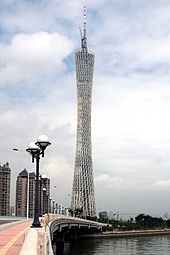
Guangzhou has twinned cities with the following cities:
| city | country | since |
|---|---|---|
| Ahmedabad |
|
2014 |
| Arequipa |
|
2004 |
| Auckland |
|
1989 |
| Bangkok |
|
2009 |
| Bari |
|
1986 |
| Birmingham |
|
2006 |
| Bristol |
|
2001 |
| Buenos Aires |
|
2012 |
| Dubai |
|
2012 |
| Durban |
|
2000 |
| Ecatepec |
|
2016 |
| Fukuoka |
|
1979 |
| Genoa |
|
2016 |
| Gwangju |
|
1996 |
| Hambantota |
|
2007 |
| Harare |
|
2012 |
| Istanbul |
|
2012 |
| Ekaterinburg |
|
2002 |
| Kazan |
|
2012 |
| Kota Kinabalu |
|
2011 |
| Kuwait City |
|
2012 |
| Linkoping |
|
1997 |
| Łódź |
|
2014 |
| los Angeles |
|
1981 |
| Lyon |
|
1988 |
| Manila |
|
1982 |
| Mombasa |
|
2018 |
| Noboribetsu |
|
2012 |
| Petaling Jaya |
|
2012 |
| Pokhara |
|
2014 |
| Quito |
|
2014 |
| Rabat |
|
2013 |
| Recife |
|
2007 |
| San Jose |
|
2012 |
| Santiago |
|
2017 |
| Surabaya |
|
2005 |
| Sydney |
|
1986 |
| Tampere |
|
2008 |
| Valencia |
|
2012 |
| Vancouver |
|
1985 |
| Vilnius |
|
2006 |
| Frankfurt am Main |
|
1988 |
Eponym
The asteroid (3048) Guangzhou , discovered on October 8, 1964, has been named after the city since 1989.
Web links
- Official website (Chinese, English)
- Official Website - China Network (Chinese)
- Website about the city at www.lifeofguangzhou.com (English)
- Water supply and water pollution in Guangzhou on www.scinexx.de
Individual evidence
- ↑ a b Guangzhou Local Government ( March 23, 2015 memento in the Internet Archive ), accessed April 24, 2019
- ↑ Guangdong (China): Prefecture Level, Cities & Counties - Population Statistics, Maps, Graphics, Weather and Web Information. Retrieved February 7, 2018 .
- ↑ World Urbanization Prospects - Population Division - United Nations. Retrieved July 23, 2018 .
- ↑ China opens longest railway line in the world. In: handelsblatt.com. December 26, 2012, accessed June 6, 2014 .
- ↑ 广州 5 月 地铁 客流 创新 高 达 13620 万 人次 In: China News Service , June 16, 2011 (Chinese)
- ↑ 运营 总部 总结 “保 开通 、 保 亚运” 工作 经验 表彰 先进 ( Memento from July 18, 2011 in the Internet Archive ) Press release of the operating company from January 13, 2011. Accessed on April 24, 2019.
- ^ Case Study - Motocycles in Guangzhou, Karl Fjellstrom 2008 - Archived copy; PDF file, 9.1 MB ( memento of September 17, 2012 in the Internet Archive ), accessed on April 24, 2019
- ↑ ACI - Airport Council International - Passenger Traffic for past 12 months ( Memento of August 12, 2011 in the Internet Archive ), accessed on April 24, 2019
- ^ The Global Financial Centers Index 23. In: Archived copy; PDF file, 3.0 MB. Financial Centers Futures, March 2018, archived from the original on March 27, 2018 ; accessed on April 24, 2019 (English).
- ^ Matthias Kremp: Tianhe-2: China becomes supercomputer superpower. In: spiegel.de. June 15, 2013, accessed June 6, 2014 .
- ↑ Mercer's 2018 Quality of Living Rankings. Retrieved August 18, 2018 .
- ↑ Minor Planet Circ. 15089


